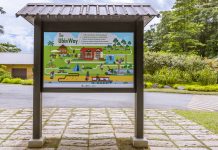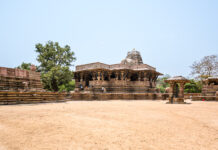Our Planet’s Landmark Series #8
One of the ancient capitals of Sri Lanka, Anuradhapura is famous for its well-preserved ruins of ancient Sri Lankan civilisation. Following Tambapanni and Upatissa Nuwara, Anuradhapura was the third capital of the Rajarata Kingdom.

The excavations here showed it was the capital of the Sinhalese from the 4th Century BCE to 11th Century CE. As a sacred city for Buddhists, it is today surrounded by monasteries spread over an area of over 40 sq km.
Sri Lanka’s Ancient Capital Anuradhapura
While it may have become the capital only in the 4th Century BCE, the carbon dating and archeological data reveal the city was actually founded in the 10th Century BCE. The excavations here uncovered the existence of protohistoric habitation of humans in the citadel.
Incidentally, the protohistoric Iron Age spans from 900 BCE to 600 BCE. The appearance of iron technology, pottery, the horse, paddy cultivation, and domestication of cattle mark this era.

Buddhism & Anuradhapura
Historical records show Emperor Ashoka of India had renounced wars meant to expand his empire in the 3rd Century BCE. Post that, he sent his son Mahinda to Sri Lanka for spreading the message of peace. It is believed that this period was to be between 250 to 210 BCE. This is the point at which a kingship began here and a civilisation developed based on one of the most significant religions of South Asia, Buddhism.
Then on, Anuradhapura remained, and still is, an important centre of Theravada Buddhism. Little wonder you’d find pilgrims from across the globe rubbing shoulders with heritage-hunting travellers! Buddhist pilgrims still visit and pay their respects in the various temples, stupas, and shrines across the ancient city of Anuradhapura.

Anuradhapura & Town Planning
Located 205 km North of Colombo, it is situated on the banks of the historic Malvathu River. Anuradhapura was buried deep in the jungles. This provided it a natural defence from the invaders. Additionally, being close to Sri Lanka’s Northwestern and Northeastern ports was another strategic advantage.

Here, you’ll also find some of the most complex irrigation systems of the ancient world. Situated in the dry zone of the country, the ancient administration authorities built many tanks to irrigate the land. Most of these tanks still survive.
The excavations unearthed the ruins of three types of structures – monastic buildings, Dagobas (bell-shaped masonry or Stupa), and Pokunas (bathing tanks).

Dressing up Buddha
The largest Dagoba (Ruwanwelisaya) is 1100 feet in circumference. Here, dressing up Buddha happens 3-4 times a day as worshippers from far and wide bring 1100-feet long cloth and drape the Dagoba along its circumference. Since the belief is that Buddha’s relics are inside the Dagoba, this ritual symbolises treating the Dagoba as Buddha and dressing it as a Buddhist monk.
Acknowledging its historical and cultural importance, UNESCO inscribed Anuradhapura as a World Heritage Site in 1982.
























